The Bagpipe Society
Lincolnshire, Lancashire and Scotch Bagpipes: Regional and Pastoral bagpipes in 17th Century England
There is a widespread belief that numerous distinctive regional bagpipes formerly existed in England. This is largely based on a handful of continually recycled 17th century references. In fact, these references mention only three instruments - the “Lincolnshire”, “Lancashire” and “Scotch” bagpipes. In general, the discourse has suggested either that the Lincolnshire and Lancashire instruments didn’t exist, the references simply reflecting the popularity of ordinary bagpipes in those counties; or that they were purely regional peasant bagpipes, long defunct and now unidentifiable; while references to the “Scotch bagpipe” in an English context have largely been ignored. I would like to suggest an alternative paradigm - that these bagpipes existed, but were essentially refined “pastoral” instruments, largely developed by professional woodwind makers for use in aristocratic masques, plays and pastoral entertainments. And far from being lost to history, it is likely that at least two of these instruments are still being played.
PASTORAL BAGPIPES IN EUROPE
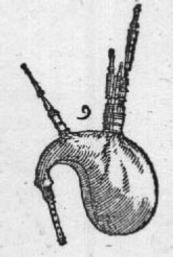
“Pastoral” was one of the most important movements in early modern elite culture. Central to it was an idealization of the life of shepherds: thus the close association of shepherds with bagpipes led throughout Europe to the creation of numerous “pastoral” bagpipes. Largely derived from local peasant bagpipes, they were distinguished by a more refined and elaborate construction, typically using expensive materials like imported hardwoods, ivory and silver, and often by significant musical development, particularly extension of the chanter range. In addition, there was a definite preference for quieter, cylindrically bored chanters (“smallpipes”), and they pioneered the adoption of bellows power.
Such instruments start to come into view around the mid-16th century. Some are now known only through the pages of period organologists like Praetorius and Mersenne, though a few survived into the modern era. Several also developed some popularity beyond their home region, and three were to impact on English bagpiping: the Italian Sordellina, the French Musette, and a central European smallpipe Praetorius calls the “Dudey”.
PASTORAL BAGPIPES IN ENGLAND

Throughout the 16th and 17th centuries bagpipers were regularly employed at the English Court and at aristocratic entertainments, and will almost certainly have been playing fashionable refined forms of the instrument. The first evidence of such instruments in Britain is a 1547 inventory of Henry VIII’s instrument collection, which lists five bagpipes made from ivory, probably smallpipes of some sort. Over the next 150 years numerous references to pipers in the employ of gentlemen hint at sophisticated and expensive instruments: like the “soft” bagpipes used in Edward VI’s Masque of Bagpipes (1553), presumably some form of smallpipe; the “boy” employed by Yorkshire diarist Sir John Reresby, who seems to have played a bellows-blown smallpipe (1656); or the piper employed by Lincolnshire MP Sir Freschville Hollis, with his “pipes of ebony tip’t with silver” (1668).

Though there is very little detail in such references, the Musette, Sordellina and Dudey were all known in England, apart from any indigenous developments. The Musette and Sordellina were popularized by a series of virtuoso visitors, including Francois Langlois, a Parisian art dealer who played both, and Canon Manfred Settala of Milan, inventor of a highly developed, multi-key form of Sordellina. Both men are known to have visited London in the 1630s and to have been welcomed into the highest society. Thus we find Salathiel Humphries, a leading London piper, owned a Musette; while Hale, another celebrity piper from Derbyshire, played a multi-keyed, double-chanter instrument probably influenced by the Sordellina. However, it was the Dudey that was to have the longest lasting influence on British piping.
PASTORAL METAPHOR – “NORTHERN” AND “SCOTCH”
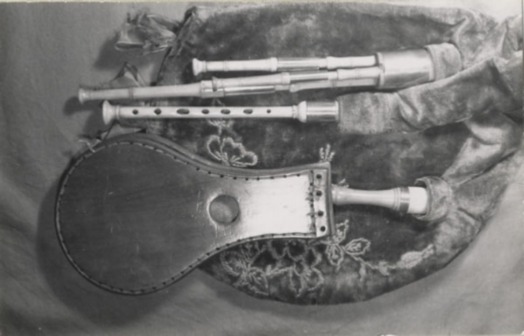
In 17th century England “the North” was seen as the archetypal locus of the rustic, as the true home of innocence, simplicity, and the pastoral, and equally of the mirror image: barbarity, crudity and backwardness. Thus within the English Pastoral paradigm the words “Northern” and “Scotch” seem to have developed a metaphorical usage, and often seem to prefigure the word “folk”. Indeed the word “Scotch” seems to have emerged within the paradigm, and was initially confined to it: it also had a certain geographical vagueness, and could at times incorporate northern England.
Though English Pastoral focused on northern Britain as a whole, the emphasis tended to shift over time. In the early century it seems to have been on a line of counties that marked the start of the north to contemporary minds, running from Lincolnshire through Nottinghamshire and Derbyshire to Cheshire and up to Lancashire; by the mid-century the main focus seemed to have shifted northwards to concentrate particularly on Lancashire; by the end of the century it had shifted even further north to the border counties and Scotland.
One of the most striking features of the references to Lincolnshire, Lancashire and Scotch bagpipes is the way they seem to closely parallel this shifting emphasis. From about 1550 to 1620 we hear of a “Lincolnshire bagpipe”, from the 1630s it is rapidly replaced by a “Lancashire bagpipe”, and as these references fade towards the end of the century we start to hear mostly of the “Scotch bagpipe”. There is certainly a suspicious symmetry here. Perhaps “Lincolnshire”, “Lancashire” and “Scotch” bagpipe in this context really meant something like “Pastoral bagpipe”.

Indeed, once the metaphorical element in these names is understood, it becomes clearer that we are dealing with real instruments. As we shall see, the evidence tends to place them in a much wider region than the names would suggest, with some of the most compelling references from neighbouring areas, and the bulk of them actually from London. The names are too regionally specific, because they were essentially brand names.
THE SCOTCH BAGPIPE
By the late 17th century the focus of Pastoral was starting to centre on Scotland, signified by a decline in references to “Northern” music within the London music industry and a sudden vogue for “Scotch Songs” and “new Scotch tunes”, a lot of it actually created in London. And it is at precisely this time that a whole raft of references to the “Scotch bagpipe” suddenly appear in the record, mostly in the London theatre.

Possibly the first of these references are in Head’s The English Rogue (1665) and Shadwell’s The Humourists (1671). Both include a rare snippet of information about the instrument – that it was bellows blown. A few years later between 1692 and 1695 James Talbot of Cambridge wrote down descriptions and measurements of three bellows-blown smallpipes in the Royal collection. One is clearly a version of the Dudey, and is described as “Bagpipe, Scotch”.
The main differences between Talbot’s bagpipe and the Praetorius Dudey are the bellows, and the closed-end chanter pitched in the Musette key of G rather than the Praetorius e-flat. This distinctive form of the instrument is still being played, though it has evolved. It re-emerges in the record 100 years later as the “Northumberland Smallpipe”, around the time when a series of major refinements were being made by Tyneside pipe makers.
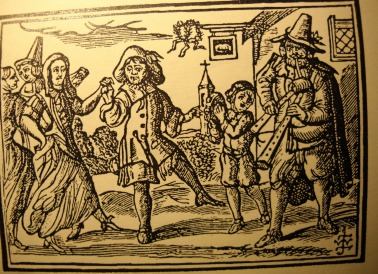
It is hard to believe, however, that the Dudey made no appearance in Britain until the 1660s. It seems to have been known over much of central and northern Europe by the early 17th century, including the Low Countries, northern Germany, Poland and the Baltic states, areas with which eastern Britain had major trading links. In fact, there are two isolated references to “Scotch bagpipes” from early in the century, and these might reflect the initial naturalization of the Dudey. One from 1615 could mean no more than “bagpipes from Scotland”, in the context of a vicious satire on Robert Carr, the Scottish Earl of Somerset (“Don Quixotes Milles are still Scotch Bagpipes to him”). However, an earlier reference, from the household accounts of the Earl of Huntingdon at Ashby in Leicestershire, tells us that in November 1606 he paid 3s 4d “for a pair of Scotch bagge-pipes for the fool”. Given the purely functional, domestic context, this certainly sounds as if it refers to a distinctive named instrument.
THE LANCASHIRE BAGPIPE
In the middle decades of the century the rural archetype lay further south, and the references are to “the Lancashire bagpipe”. Although the sources become scarcer and vaguer as we go back in time, it is possible to suggest an identification of this instrument as well. The first reference to the “Lancashire bagpipe” comes in 1634, in the massive procession opening Shirley’s masque the Triumph of Peace. A manuscript listing the cast and running order describes it as headed by “Thomas Bassett ye Lancashire Magpipe [sic] And Iohn Seywell the Shalme rydeinge a breast together”.
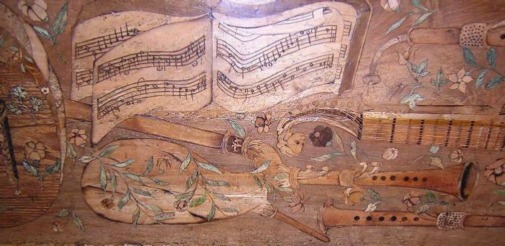
Two things are worth noting here. First, the use of the definite article, and the purely functional nature of the list, suggest this was an instrument actually known by this name. Secondly, to head what was an extremely noisy procession, and to match the volume of a shawm, this must surely have been a loud, and thus conical bored instrument. Indeed, the distinction between “loud” (outdoor) and “soft” (indoor) music was important to contemporaries, and a smallpipe would have been considered quite wrong in this context.
This initial appearance was within an unmistakeably “pastoral” context, though one that reflected the negative side of the paradigm, parodying rather than idealizing the rustic. The piper was associated with a “northern” anti-masque within the procession, a satirical burlesque featuring lower class and rustic characters.
The second reference from the same year (1634) is also from London, and again the context is an urban and educated presentation of the rural and unsophisticated. In Heywood and Brome’s The Late Lancashire Witches a piper is bought in to replace bewitched fiddlers:
“I have heard my Aunt say twentie times, that no Witchcraft can take hold of a Lancashire Bag-pipe, for it selfe is able to charme the Divell, ile fetch him.”
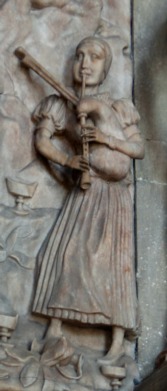
This play was basically a musical, and the instrument was spotlighted at this point. Thus its second appearance in the record is as a stage instrument, not so dissimilar to its first appearance in the masque procession. It is hard to resist the idea that we are dealing here with a “pastoral” instrument - a conical bore great pipe that has had a fashionable makeover by professional instrument makers, perhaps in the workshops of London.
There is only one instrument in the record that matches this description. It appears in a remarkable series of paintings made in London and Oxford between 1674 and about 1720 by the Dutch émigré Egbert van Heemskerck and his son of the same name. These depict low-life tavern and festival scenes, and frequently include a great pipe configured exactly like the pastoral Dudey - bellows blown, with three drones in a cylindrical common stock resting over the bellows arm - at the time a unique configuration. The only difference is that this bagpipe features a second tenor instead of a baritone drone These pictures appear to be the first images of the instrument nowadays known as the Lowland or Border bagpipe, names invented by Scottish antiquarians in the late18th and early 19th centuries.
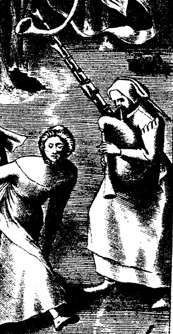
Like the “northern” anti-masque and the “Lancashire” play, the Heemskerck images can be seen as rural burlesque or anti-pastoral. On a more literal level, I think they show a pastoral instrument which had filtered down to street and tavern, which seems to have been the ultimate fate of most pastoral bagpipes.
THE LINCOLNSHIRE BAGPIPE
By the time we reach our earliest instrument we can only make the most tentative suggestion as to an identification, though that identification is somewhat startling. References to Lincolnshire bagpipes occur between 1547 and 1670, but the main concentration is within a much shorter period between 1590 and 1617, and the instrument seems almost totally undocumented in what was probably its heyday from about 1550 to 1600. Most references are ambiguous, and could mean no more than “bagpipes from Lincolnshire”, yet it is strange to find such a concentrated regional identification in an era where bagpipes were still common and widespread in England, and noteworthy that the earliest and most compelling references appear around the time when refined pastoral bagpipes come most clearly into view in the rest of Europe. It is also the time when the shifting rural archetype was most often associated with the line of northern border counties from Cheshire to Lincolnshire
- with Lincolnshire the closest to London.
Perhaps the most convincing reference is Armin’s account of Christmas at Haughton Hall in Nottinghamshire, published 1600:
“At Christmas time, amongst all the pleasure provided, a noyse of minstrells and a Lincolnshire bagpipe was prepared - the minstrells for the great chamber, the bagpipe for the hall "
After all, Haughton is not actually in Lincolnshire, though only about ten miles from the border.

There are only a few clues as to the nature of this instrument. Peacham in 1636 refers to: “a lustie tall fellow……cheekes puffed and swolne as if hee had beene a Lincolne-shire bagg-piper…”, which would suggest a mouth-blown instrument; while Fuller in 1642 writes: “Lincolne-shire bagpipes. I behold these as most ancient, because a very simple sort of music, being little more than the oaten pipe improved with a bag…”, which might suggest a smallpipe – the home-made oaten pipe being the ur-smallpipe chanter.
This could fit the early Dudey, and Lincolnshire’s position certainly made it susceptible to influences from northern Europe. Unfortunately, as we have seen, the Dudey may have been known as the Scotch bagpipe as early as 1606. Moreover, that reference came from Ashby in Leicestershire, close to both Lincolnshire itself and to the Lincolnshire bagpipe’s appearance at Haughton Hall in Nottinghamshire. So if the Ashby “Scotch” bagpipe was the same instrument as in the late century, the “Lincolnshire” bagpipe was probably something else.
A better contender might be the Sordellina, or at least some form of double-chanter bagpipe. According to the Victorian ballad expert J.P. Collier “the fac-simile of a street musician at the head of this reprint, gives an exact and contemporaneous representation of the cumbrous “Lincolnshire bagpipe” the “melancholy drone” of which is celebrated by Shakespeare” (1868). It’s a poor image, but appears to show a double chanter bagpipe with a single drone.
Collier’s statement is remarkably definite. He must have been well aware that this was the most commonly used stock bagpipe image in the broadside industry, yet this doesn’t seem to have dented his confidence. Unfortunately, he doesn’t give his source, and it doesn’t boost our confidence that Collier had a long history of forgery and deception.
Perhaps the image originally appeared with The Sweet ballad of the Lincolnshire Bagpipes mentioned in a text of 1590: unfortunately, no one has been able to find a copy. However, it has been suggested that ballad was a version of The Merry Bagpipes, of which numerous copies do survive, so it’s interesting that they frequently bear the image seen here – another, and more convincing double-chanter bagpipe.
It’s tempting to dismiss this flimsy evidence, yet if we move a little further west along our line of northern border counties to Derbyshire, we find what is probably a keyed double-chanter bagpipe among the display of genteel instruments inlaid into the Eglantine table at Hardwick Hall. The table dates to c.1567, slap-bang in the middle of what was probably the Lincolnshire bagpipe’s heyday. And, of course, it is also in Derbyshire that we find a highly sophisticated double-chanter instrument in the hands of Hale a century later. Perhaps the proximity of Lincolnshire, Armin’s “Lincolnshire bagpipe” just over the border in Nottinghamshire, and Hale and the Eglantine pipe next door in Derbyshire, is more than coincidence.
If this really is the Lincolnshire bagpipe, it could be a form of Sordellina. However, there are features common to the Hale and Eglantine instruments (and even the ballad bagpipes) which might suggest an indigenous origin. Their long chanters, for example, are more like those seen on some of the more compelling images found in English churches from the 15th /16th centuries, as is the near parallel mounting of Hale’s chanters, and the twin stocks of the Eglantine. On the other hand, Hale’s complex key system could well reflect the influence of the Italian instrument.
Whatever it was, the Lincolnshire bagpipe was known in London and to the educated classes, it’s most convincing reference is in the context of a wealthy gentleman’s Christmas entertainment, and the most likely contenders are the sophisticated Eglantine and Hale double-pipes. Many of the references also seem to place it in the north midlands. The evidence points, in fact, to an elite bagpipe with regional roots: these could include its pastoral remodelling, as we now know of several skilled bagpipe makers in the provinces. Indeed, Hale seems to have been a maker, and his instrument may have been of his own design and manufacture.
In contrast, references to the Scotch and Lancashire instruments seem to centre them squarely in London, with barely a hint of authentic regional roots. There is, however, other evidence to consider.
THE SCOTCH BAGPIPE: PART 2
While there is abundant evidence for the Dudey in Scotland and Northern England during the 18th century, there is virtually no trace in the 17th century record. In this period the references place the “Scotch bagpipe” firmly in London and the south-east. There are, however, a group of period images from Scotland and northern England that show the characteristic and unusual Dudey drone position, with the drones lying across the body. This is the best evidence that the “Scotch” name was not entirely metaphorical - though unfortunately, like most bagpipe images, they are not without problems.
The earliest image is from a carved chimneypiece at Burton Agnes Hall in North Yorkshire, probably dating to around 1598-99. It is copied from a Bruegel painting which shows the two drones in a typical Flemish vertical, forward-facing position - however, the sculptor has altered the angle of the upper body so that the drones lie across the player’s chest. Whether this was accidental, or a deliberate alteration to show a configuration more familiar to the sculptor or his employer, we can’t say, but if the latter we could see here the influence of the Dudey on the indigenous great pipe.
Even more enigmatic is a small statue atop a house in Jedburgh, apparently depicting a mouthblown smallpipe with a single drone in the overarm position. However, while the house bears a lintel date of 1605, it has been considerably altered over the years, and the current structure is essentially Victorian. It is not clear if the piper was ever part of the original structure, so the question is, when was he made and when was he added? Is this a local carving or an import? Is it part of the original house or a Victorian conceit? It’s often claimed Robin Hastie the town piper lived here, which might suggest a mid-18th century date, but this seems to be a reverse deduction from the presence of the statue. There is, however, no doubt it looks like a crudely represented Dudey, or at least evidence of its influence, and it looks 16th/17th century in style.
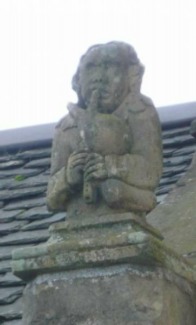
There is a similar carving on a cottage in Ceres, Fife. Again, it appears to show a mouth-blown smallpipe with a single drone lying across the chest. Local histories attribute it to John Howie, a 19th century mason who lived in the house, or his 18th century grandfather. However, it looks older than that, and is virtually identical to a drawing in Dalyell’s Musical Memoires (1849) of another statue, which he describes as 15th century from Melrose Abbey - though it wasn’t there when looked for 50 years later – and is comparable to the remains of an early 17th century carving at Craigievar castle in Aberdeenshire. All this might suggest the work of the same mason, or of different masons working from a common image. Craigievar may be the key to understanding this group: it was built between 1610 and 1626 by William Forbes, otherwise known as “Danzig Willie”, a wealthy merchant who made his fortune in the Baltic trade. Perhaps these are the first images of the imported Dudey: it’s noteworthy that in all three carvings the position of the bag and hands are subtly European, British piping imagery favouring a more horizontal, underarm bag position, with the bag hand on top of the chanter.
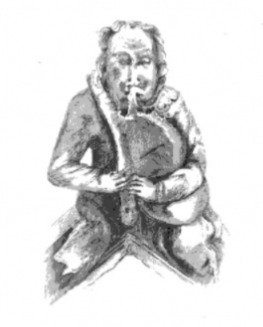
Perhaps the most intriguing of these carvings comes from the gates of Ballinton House near Stirling. This shows a mouth-blown, two-drone bagpipe, with the drones lying across the arm. Though usually taken to represent a great pipe, it could well be a smallpipe given the short drones, and that the piper’s proportions suggest he could be a dwarf - which given the close association between dwarfs, fools, and bagpipes, seems quite possible. Either way, we have here the classic Dudey drone position, and a piper in dress that suggests the first half of the 17th century – although the old house was pulled down sometime after 1729 and rebuilt, so this might be an early 18th century carving and the archaic dress a livery.
The last of our images is a calligraphic vignette in a 1661 dated copy book from either Sproxton in Leicestershire or Sproxton in North Yorkshire. This also seems to show a great pipe with the drone across the body. Unfortunately, the book seems to be copied from one of the popular “Writing Schoolmaster” books of the period, and I’ve not been able to find out if the drawing is the writer’s own invention or a copy from his source book. If the latter it could push the image back to Bales’ “Writing Schoolmaster” of 1590, but also remove the vernacular origin, and the possible Leicestershire location and potential link to the Ashby “Scotch bagpipe” of 1606.

Clearly every one of these images taken alone is problematic. But viewed as a group there is a clear pattern that perhaps rules out coincidence. All occur north of the Wash, within the orbit of “Scotch” at its most generalized; and all in the east, in places with good access to the east coast ports, and hence to both the coastal maritime highway and the latest fashions from London, and to the trade routes between Britain and the ultimate source of the Dudey: the Low Countries, the Baltic, and central Europe. Indeed, if we remember the instrument’s long-term association with Tyneside, it’s not hard to imagine the Dudey entering through various east coast ports, but finding a particular home among the workshops and musicians of Newcastle. This would be enough to render the instrument “Scotch”.
THE LANCASHIRE BAGPIPE: PART 2
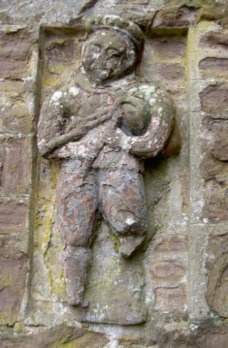
The literary evidence for the Lancashire bagpipe also places it squarely in London. And if my identification of the instrument as the Heemskerck bagpipe is correct, then so does the imagery - or at least it places it London, Oxford and the surrounding areas – unless we take the Burton Agnes and Ballinton pictures as evidence of an evolution towards the instrument in northern Britain.
Even the most regional looking references are deeply ambiguous. The initial appearance of the instrument in the “northern” anti-masque and Lancashire themed stage play might suggest a genuine Lancashire connection, but it could just as easily show the London public’s acceptance of a purely metaphorical name. Indeed, the only reference that seems to directly place the instrument in Lancashire comes in 1702, well past its heyday, when the antiquarian Ralph Thoresby, visiting Preston Guild, complained that he “rose by five, having got little rest; the music and Lancashire bag-pipes having continued the whole night at it, were now enquiring for beds.” But precisely because it is in the county, the phrase could simply mean “bagpipes in Lancashire”. In any case, as a strong bagpiping region the county might well have adopted any advanced London instrument by this time.

There is other evidence for a genuine regional connection, and from around the same time, but is a lot more circuitous. In the early 18th century several examples of alleged Lancashire and Cheshire bagpipe music were published in London: much of it exceeds the traditional bagpipe range, raising the possibility that an overblowing bagpipe was known in north-west England at this time. There is evidence for such an instrument: in 1729 the Scottish traveller George Skene observed the Cumbrian piper (and probable pipe-maker) James Bell play what sounds like an overblowing great pipe in low D, and an instrument exactly like this appeared in London 14 years later. This was “The Pastoral or New Bagpipe” described by John Geoghegan in his tutor of 1743 - a highly refined and developed form of the instrument painted by the Heemskerks, our tentative Lancashire bagpipe.
Geoghegan was Irish, and his instrument is generally recognized as the early form of the Irish Union pipes, though he makes no Irish or other regional connection in his text. He may have been associated with a group of Anglo-Irish musicians in Dublin which included Larry Grogan, according to O’Neill the earliest known player of the Union pipes. Grogan was born in 1702, so was probably playing from about 1720 till his death in 1728: this puts his instrument in the same time frame as James Bell’s great pipe. There is an obvious connection here: in a time of poor roads but excellent sea lanes, if attempts were being made in north-west England to create an overblowing bagpipe, the nearest big city liable to pick up on and refine these developments was not London or Edinburgh but Dublin, second city of the Empire.

If this highly developed version of our presumed Lancashire bagpipe did indeed have its roots in the north-west England/Dublin maritime culture province, this raises the possibility that the earlier and simpler form did too. Of course, that could be explained by a familiar cultural circularity – the region was undoubtedly a piping hotbed, so perhaps it adopted the London “Lancashire bagpipe” and proceeded to develop it – but the story of our other two bagpipes, let alone the European pattern, suggest we should at least take the idea seriously.
CONCLUSION
The story of this 18th century “Pastoral or New bagpipe” is a long and complex one beyond our present scope. It is also one with a lot more solid evidence: in looking at these 17th century instruments we must always bear in mind the limited and poor-quality source material, and the subsequent inevitability of both errors and gaping holes in our story. Still, hopefully some things are a little clearer. It seems very probable that the Scotch bagpipe was derived from the Dudey, and ancestral to the Northumbrian smallpipe. The case for the Lancashire bagpipe as the Heemskerck instrument, and the ancestor of our “Border” bagpipe, seems good, though definitive proof may always elude us. The Lincolnshire bagpipe remains more of an enigma, though the Sordellina or an indigenous twin-chanter bagpipe are certainly candidates. Above all, it seems clear that these were essentially refined “pastoral” instruments, whatever the extent and nature of any regional dimension.
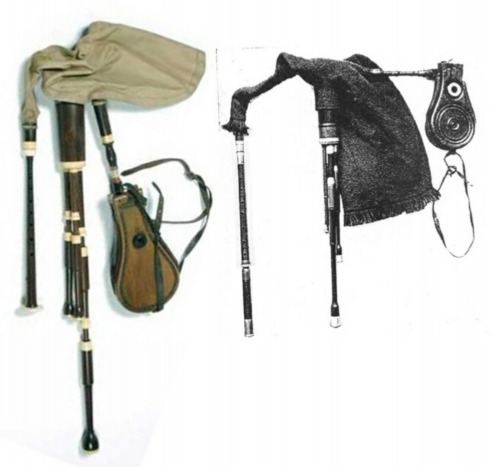
By Anon Roberts, Paul Trad Various
From Chanter Winter 2017.
- Data Processing Notice (GDPR)
-
@BagpipeSociety on X (formally known as Twitter)
-
TheBagpipeSociety on Instagram
-
 BagpipeSociety on Facebook
BagpipeSociety on Facebook
Something wrong or missing from this page? Let us know!
